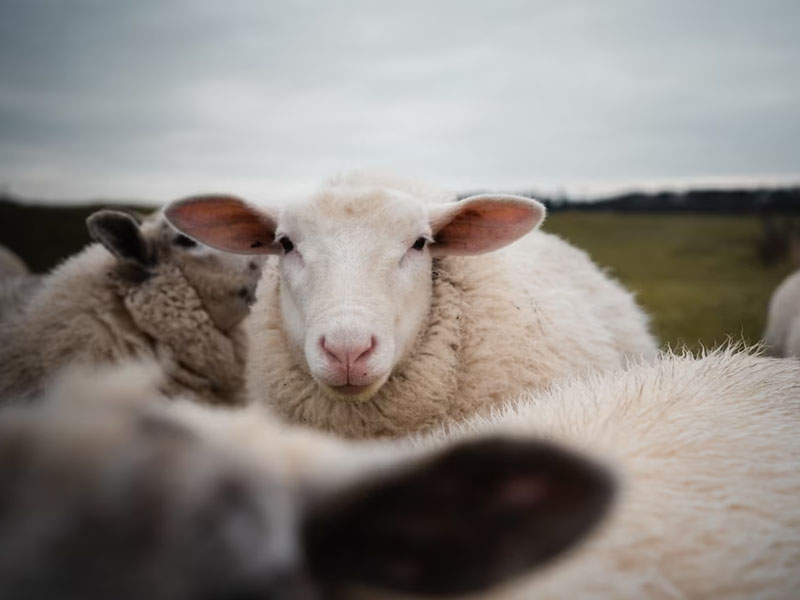Types of Wool
Wool is known for its durability, thermo-insulating properties, biodegradability, softness and resilience. Mostly, this fibre is associated with sheep, but wool also comes from goats, camels...
Within this wide variety, a wide range of wool types can be found. The process for all of them is the same. After the animal is sheared, the fleeces are collected, sorted by micronage, coloured and washed. Depending on the type of manufacture, the wool fibre is combed.
The result of this process is the hair of various animals. Although most people associate the word 'wool' with sheep, in reality, there are several different types of wool that producers obtain from animals other than sheep.
To make wool, producers collect the hair from the animals and spin it. Wool is known for its durability and heat-insulating properties; depending on the type of hair that producers use to make wool, this fabric can benefit from natural insulating effects that keep the animal that produced the hair warm throughout the winter.
In this article, we will review some of the different types of wool that exist in the world.
DIFFERENT TYPES OF WOOL
The wool comes from different animals, each with its own properties. It is therefore not surprising that there are different varieties of wool. However, there are hundreds of different types of wool in the world.
Europe
Shetland Wool
Shetland wool is sourced from the Shetland sheep, a small breed of sheep native to the Shetland Islands. Shetland wool is known for its softness, warmth and versatility. The wool is naturally water-resistant and durable enough to withstand frequent washing and wear.
- Country of origin: United Kingdom, Australia and the United States.
- Fibre origin: Shetland sheep
Arles Wool
Arles wool is a variety of wool produced in the Arles region of southern France. It is a high-quality wool and is obtained from Merino sheep raised in the area. Arles wool is highly valued by weavers because of its ease of spinning and weaving. It is one of the most prized wools in France and is highly valued throughout the world for its softness, lustre and durability.
- Country of origin: France
- Fibre origin: Merino sheep
Icelandic wool
Icelandic wool is sourced from Icelandic sheep, a breed indigenous to Iceland. Icelandic wool is prized for its unique combination of softness, warmth and durability. The wool is naturally resistant to water, dirt and odours, and contains two types of fibres that give it a distinctive texture and appearance. The quality of Icelandic wool can be influenced by the harsh climate and terrain which contribute to the quality of the wool.
- Country of origin: Iceland.
- Fibre origin: Icelandic sheep.
Merino wool
Merino wool comes from the Merino sheep, which originated in Spain but is now bred in many parts of the world. Merino wool is prized for its softness, warmth and versatility. It is naturally resistant to water, stains and odours, and is durable and crease-resistant.
- Country of origin: Spain.
- Fibre origin: Merino sheep.
Ripollesa Wool
Ripollesa wool is a high-quality wool produced in the Ripoll region of Catalonia, Spain. It is known for its softness, durability and warmth, making it ideal for use in clothing and other textile products. The wool comes from Merino sheep raised in the Ripoll mountain range. The cold climate and altitude provide optimal conditions for the sheep to produce a thick, dense fleece that is perfect for making warm garments. The wool is also naturally elastic, which means it can withstand wear and tear without losing its shape or appearance. One of the unique characteristics of Ripollesa wool is its ability to absorb moisture without feeling damp or heavy. This makes it an excellent choice for outdoor activities such as hiking or skiing, where moisture management is essential.
- Country of origin: Spain (Catalonia).
- Fibre origin: Sheep of the autochthonous sheep breed of the Ripollès region.
Majorca Wool
Majorcan wool is a variety of wool produced on the island of Majorca, Spain. It is a high-quality wool obtained from the indigenous Mallorcan breed of sheep. Majorca wool is known for being very soft and warm, with a slightly woolly texture and a medium wick length.
- Country of origin: Spain (Majorca).
- Fibre origin: Mallorcan Sheep.
Latxa wool
Latxa wool is a variety of wool produced in Spain, specifically in the region of León and Asturias. It is obtained from sheep of the lacha breed, a breed indigenous to the area. Lacha wool is known to be very soft and fine, with a silky texture and a medium wick length. This wool is often used for the production of high-quality clothing, such as suits and coats, as well as for the manufacture of fine textiles, such as blankets and carpets.
- Country of origin: Spain (León and Asturias).
- Fibre origin: Latxa sheep.
New Zeland & Australia
Corriedale wool
Corriedale is a dual-purpose sheep breed, meaning that they are used for both wool and meat production. The Corriedale breed is the oldest of all the crossbreeds, having arisen from the crossbreeding of the Merino and Lincoln breeds.
- Country of origin: New Zealand and Australia.
- Fibre origin: Corriedale ewe, a cross between a Merino and a Lincoln sheep.
Tazmanian wool
Tasmanian wool is a fine, high-quality wool produced from Merino sheep raised on the island of Tasmania. It is characterised by its softness, fineness, high crimp, elasticity, strength and ability to retain its shape well.
- Country of origin: Tasmania, South Mainland Australia.
- Fibre origin: Merino sheep.
South America
Lincoln wool
The Lincoln sheep is a breed of domestic sheep believed to have originated in England. The wool is prized for its long, lustrous fibres, which are ideal for making high-quality fabrics. Lincoln wool is commonly used in luxury fabrics such as blankets and shawls, as well as rugs and other home furnishings. The quality of Lincoln wool can be influenced by factors such as genetics, diet and shearing techniques, and proper care of the sheep's fleece is important to produce high-quality wool.
- Country of origin: United Kingdom, United States and New Zealand.
- Fibre origin: Lincoln Sheep.
Churro Wool
Churro wool is a type of wool from the Churro breed of sheep, an ancient and hardy breed originating in the Iberian Peninsula. It was brought to America by the Spanish conquistadors in the 16th century and has since been bred by indigenous communities in what is now Mexico, the southwestern United States and other parts of Central and South America. Churro wool is known for its unique texture and durability and is prized by weavers, knitters and other fibre artists for its strength and versatility.
- Country of origin: Mexico and other parts of Central and South America.
- Fibre origin: Churro sheep breed.
Alpaca Hair
Alpaca wool comes from the domesticated South American alpaca and is prized for its softness, warmth and hypoallergenic properties. There are two types of alpaca wool: Huacaya and Suri, which have different textures.
- Country of origin: Peru, Bolivia and Chile.
- Fibre origin: Alpaca, South Africa.
Asia
Kashmir's hair
Kashmir hair is sourced from the kashmere goat, which is native to Central Asia. Kashmere wool is known for its softness, warmth and luxurious feel.
- Country of origin: China, Mongolia and Iran.
- Fibre origin: Kashmere goats.
Mohair hair
Mohair wool is derived from the Angora goat and is known for its silky texture, lustrous lustre, durability and natural flame resistance. It is often blended with other fibres and is a popular choice for clothing and home textiles. The quality of mohair wool can be influenced by climate and grazing conditions.
- Country of origin: South Africa, Turkey and the United States.
- Fibre origin: Angora goats.
Camel Hair
Camel wool comes from Bactrian and dromedary camels, which are native to Central Asia and the Middle East. Camel wool is prized for its softness, warmth and durability. It is naturally resistant to water, stains and odours, is hypoallergenic and has antibacterial properties.
- Country of origin: Mongolia, China and Iran.
- Fibre origin: Bactrian camels or dromedaries.
Angora hair
Angora wool comes from the Angora rabbit, which originated in Turkey but is now bred in many parts of the world. Angora wool is prized for its softness, warmth and unique halo effect.
- Country of origin: Turkey.
- Fibre origin: Angora Rabbit.



Users Reviews